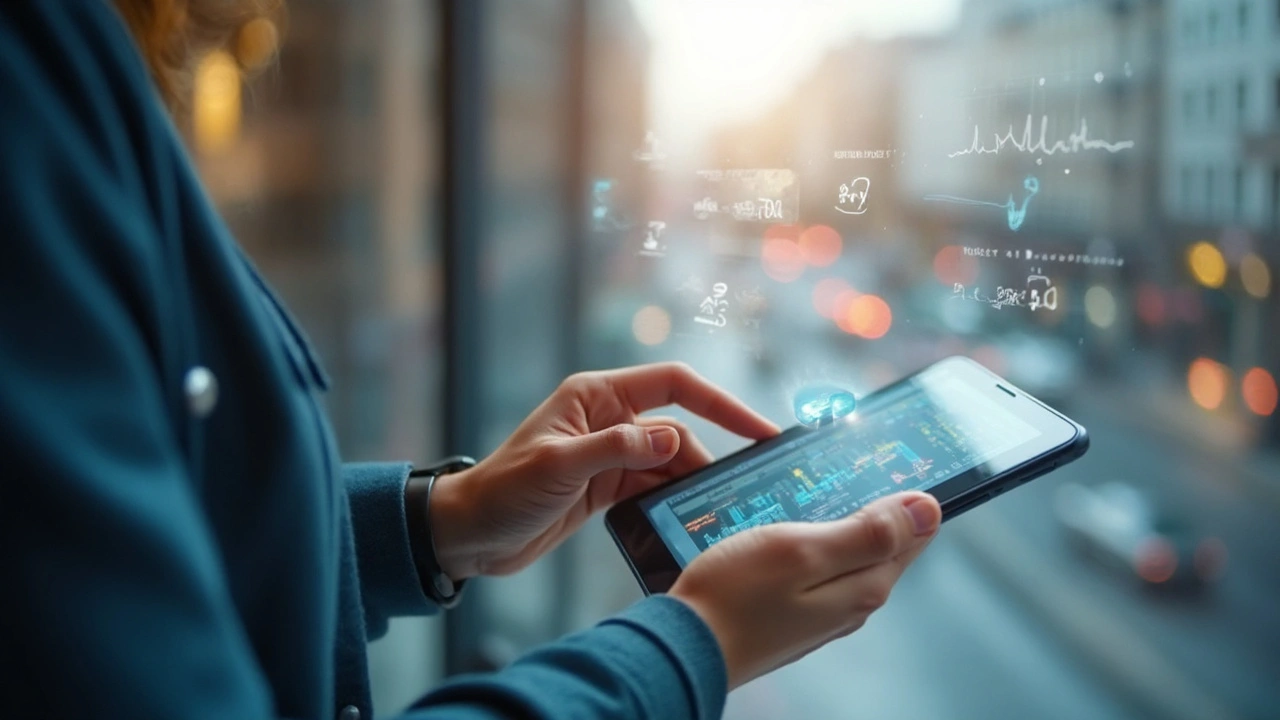AI Tips: How to Use AI to Improve Your PPC Campaigns

AI isn’t just for tech giants or Silicon Valley startups. Even if you manage ads for a small shop or a growing e-commerce brand, you’ll see big changes when you lean into AI for your PPC campaigns. It’s like having a supercharged assistant working 24/7, spotting patterns in your data that you’d never catch on your own.
Think about this: AI tools can look at your ad performance, learn from what’s working, and suggest changes in seconds. No more digging through endless spreadsheets or running the same old A/B tests by hand. Whether you want to target the right people at the best time or simply stop wasting money on clicks that don’t convert, there’s an AI tool ready to help. The key is knowing where to start, and what results to expect without falling for the hype.
- Spotting Opportunities with AI in PPC
- Smarter Targeting and Audiences
- Automated Bidding and Budgeting
- AI Ad Copy and Creative Improvements
- Staying Ahead: Monitoring and Learning
Spotting Opportunities with AI in PPC
AI has a knack for picking out chances to make your PPC campaigns better—before you even know there’s an issue. It sorts through piles of click and conversion data at lightning speed, something no human could do without help. For example, Google Ads’ built-in AI analyzes thousands of signals every second to recommend which ads to push and which keywords deserve more love. That’s not just marketing talk—Google boosted conversion rates by up to 15% for advertisers using AI-driven recommendations versus regular manual setups, according to their actual case studies.
The core idea? AI doesn’t just look at obvious data, like click-through rates. It pieces together stuff like device usage, location, time of day, even details about how users scroll or bounce away. So, it can spot patterns, such as certain products getting more clicks on mobile late at night or specific search phrases blowing up thanks to a trending topic. You don’t have to constantly check dashboards—AI is already alerting you or making suggestions.
Here are some tangible ways to use AI to spot new PPC opportunities:
- Let AI bots highlight underperforming keywords you should pause, and find search terms worth testing based on recent trends.
- Set up automated alerts when you get unusual traffic spikes or dips on your ads. This can save money and stop problems early.
- Use AI heat maps to see which ad variations grab attention and which fall flat, without manual guesswork.
- Take advantage of AI-powered audience insights tools. They break down who’s engaging with your ads, laying out new segments to target for better returns.
If you’ve been handling all this by hand, those time savings are just as valuable as the results you get. Your PPC strategy shifts from reacting to problems to jumping on new chances, right as they happen. That’s how you stay a step ahead in online ads.
Smarter Targeting and Audiences
When it comes to PPC, hitting the right audience is everything. AI is shaking things up by making it so much easier to find people who actually want to see your ads. Google Ads and Meta, for example, now offer AI-powered audience segments. They crunch piles of data from recent searches, site visits, and even offline behavior, then auto-build audiences way faster than any human could.
Here’s a simple truth: targeting is no longer just about broad demographics. AI digs in deeper. With tools like Google’s Smart Audiences or Meta’s Advantage+ audiences, you can let AI decide who’s most likely to click, buy, or sign up based on live behavior, intent, and engagement patterns. It’s like handing off a puzzle to a computer that never gets tired.
What’s cool is how AI can also spot shifts in audience trends on the fly. Say your ideal customer starts shopping at weird hours or using new search terms—AI flags this and updates your targeting before you even notice. Want a real-world stat? Google says advertisers using its AI-driven targeting features saw up to 20% more conversions in 2024.
| AI Targeting Tool | Benefit |
|---|---|
| Google Smart Bidding & Audiences | Adapts targeting and bid strategy in real time |
| Meta Advantage+ | Expands lookalike and custom audiences automatically |
Want to put this to work? Start by switching to AI-based audience suggestions in your ad platforms. Then combine this with exclusion lists, so your budget isn’t wasted on the wrong clicks. And always check up on your segments—AI’s good, but it gets better with a little help from human common sense.
Bottom line: using PPC with smart AI-powered targeting puts your ads in front of the right eyes, at the right time, and reacts way faster than you ever could alone.

Automated Bidding and Budgeting
Manual bidding is old news. These days, PPC marketers are using AI-powered automated bidding to squeeze more value from every dollar. Google Ads Smart Bidding is a solid example—it's built to pick the right bid in each auction, based on signals like device, location, time of day, and past user behavior. Basically, it learns who’s most likely to click or buy, so you’re not guessing or overspending.
Here’s how automated bidding can flip the script for your campaigns:
- Targeted Goals: Choose whether you want more clicks, conversions, or a certain return on ad spend (ROAS). The AI does the heavy lifting and adapts in real time.
- Faster Adjustments: If your market changes fast, AI reacts without needing you to check your ads every hour. It can boost your bids if it sees a hot streak, or back off if performance slips.
- No More Guesswork: Machine learning crunches huge piles of data, finding patterns about who’s clicking, when, and why. This leads to smarter bids every time.
Stuck thinking you’ll lose control? Actually, you set thresholds and budgets, so you still decide how much to risk. For example, set a daily maximum spend or a target CPA (cost per acquisition), and AI tools handle the rest. According to Statista, over 86% of companies running Google Ads use automated bidding features. That’s a lot of marketers who’d rather use their time for strategy than number-crunching.
The trick is to combine AI with frequent checks on your actual business results. If ROAS drops or you see weird swings, tweak your settings and add clear boundaries. Your campaigns aren’t meant to run on autopilot forever—a little human oversight keeps AI honest and your budget safe. In short, automated bidding and budgeting means less wasted spend, fewer headaches, and more energy for growth.
AI Ad Copy and Creative Improvements
Writing great ad copy can feel like guesswork, but AI is making the process way smarter and a lot less painful. The latest AI-powered tools like ChatGPT, Jasper, and Google’s Performance Max let you punch in product details or campaign notes, and they’ll spit out dozens of headline and description options in seconds. No more staring at a blank page. These tools crawl successful ads, pick up on what’s trending, and help you avoid language that’s played out or just doesn't convert.
One cool fact: Google’s responsive search ads now automatically split-test multiple headlines and ad descriptions. The system learns which combinations work best for your audience, trims the losers, and serves the winners more often. This means your copy improves over time without you hitting “refresh” a hundred times or manually swapping out lines.
AI doesn’t stop at words. Some software generates image suggestions or even tweaks colors and layouts based on what’s working for your industry. For e-commerce brands, platforms like Shopify and Canva use AI to resize images, swap backgrounds, and recommend design tweaks that drive more clicks and conversions.
Want some go-to tips on working AI into your ad creative?
- Feed the AI with your previous top-performers, not just generic info. The more context, the better the results.
- Always review and personalize; AI can deliver a strong draft but adding your own voice (or brand tone) is what makes it click.
- Test AI-generated calls-to-action versus your originals. Sometimes, even switching a couple of words boosts click-through by 10% or more.
- Let AI suggest visuals if you’re running display ads—images that match ad copy are more likely to grab attention.
Just a quick stat that shows this isn’t all hype: after adopting AI-generated ad copy, some businesses saw click-through rates jump by up to 35%, based on Google internal reports from late 2024. So, if writing ads isn't your favorite part of the job, letting AI handle the heavy lifting is a real game changer.

Staying Ahead: Monitoring and Learning
Even with the coolest AI tools running your PPC campaigns, you still need good old-fashioned monitoring. It’s not about checking once a month and hoping for the best. The biggest brands are tracking results in real time, but even if you’re a one-person crew, checking in often keeps nasty surprises away and lets you spot what’s working before it’s too late.
AI makes this easier. There are platforms that’ll alert you if your ad performance dips, detects weird click spikes, or sees your budget getting chewed up too fast. For example, Google’s Performance Max and Meta’s Advantage+ actually ping you when major trends change. It’s almost like your campaigns talk back to you. And, they don’t just flag problems — they show you what needs to be fixed, so you’re not wasting cash.
"AI-powered monitoring opens up data-driven decisions that marketers just couldn’t do reliably at scale five years ago," says Ginny Marvin, Google Ads Liaison. "It’s now core to staying competitive in digital marketing."
Don’t get lazy though. Machines help, but the best results come when you pair their alerts and reports with your own common sense. For example:
- Set up AI-driven alerts for things like sudden drop in conversions, spend spikes, or a fall in ad quality scores.
- Use dashboard summaries from platforms such as Google Ads or SEMrush to get a single view of all your campaigns, down to the keyword and timing.
- Review ‘learning’ insights from AI: those automated suggestions to pause losers, boost winners, or even change targeting.
Quick stat: According to a 2024 survey by WordStream, marketers using AI-based PPC monitoring saw a 17% faster reaction time to issues and a 23% lift in campaign performance after acting on automated insights.
| Feature | With AI Monitoring | Without AI Monitoring |
|---|---|---|
| Average Reaction Time | 1.5 days | 6.3 days |
| Performance Improvement | +23% | +8% |
The big takeaway? Let AI handle the heavy lifting for reporting and trend-spotting, but always keep your hands on the dashboard. That’s how you keep your edge as algorithms — and competitors — get smarter every day.